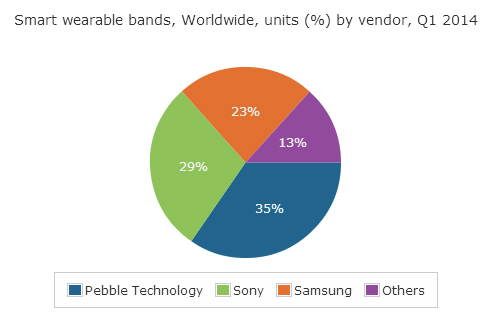Wearables: The ones we use versus the ones we really want

Virtually every big-name gadget brand — and several non-gadget brands for that matter — are racing to develop a wearable product that will take the sector to the next level. From glasses to watches, wristbands to pendants, the market is awash with wearable options — but which ones do people really want to wear?
While the answer to that question may seem a bit arbitrary, there's actually plenty of insight available on the subject. Let's start with the facts.
Looking at wearable device sales provides a glimpse at where consumers are willing to spend on the generally fledgling technology. A recent report from the analyst firm Canalys shows some clear leaders on the sales front.
Unfortunately for Google Glass, for now it looks as though consumers are more apt to put wearables on their wrists than on their face, as wristbands currently dominate the wearables market. In Canalys's two wearable band segments, smart bands and basic fitness bands, the Pebble smartwatch and the Fitbit fitness-tracking band were the respective leaders.
Out of an estimated total of 2.7 million wearable bands shipped worldwide in the first quarter of 2014 (including smartwatches and fitness bands), Fitbit earned a hefty 50 percent of that market. In the subcategory of smartwatches alone, Pebble earned 35 percent of the market, which is estimated to be around a half million units:

Bands are beating other wearable form factors due to their appeal to a broader section of consumers, according to Canalys analyst Daniel Matte. Where smartwatches and eyewear tend to lure in a more techie audience, bands (particularly those of the fitness variety) have a clear value proposition and a low enough price point to entice curious early adopters.
According to Matte, Fitbit is likely the leader because it is plain and unobtrusive. As for the other major wearable band players such as the Jawbone and Nike's Fuelband (which ironically has been discontinued), Matte said they share some of the sweet-spot qualities with Fitbit: they're thin, light and fashionably acceptable. Matte said that bands also win out over clips or pendants, since they're less likely to fall off or get lost.
"Wearable bands are increasingly more popular because they provide more functionality and are less easy to lose. Users also appreciate the advantages of smart bands, which have displays and the ability to run apps right on the device," Matte said. "This is reflected in greater usage and continued engagement metrics."
What our editors think
Another way to gauge what wearables people actually want to wear is to ask those who've used them all — or at least tried to — in the name of journalistic research. Teena Hammond, senior editor for ZDNet sister site TechRepublic, has tested the Fitbit Flex, the Jawbone UP, the Nike+ Fuelband, the Misfit Shine, as well as the posture-monitoring LumoBack, and of course, Google Glass.
While Hammond admits that many of the devices currently on the market are not likely to remain as the industry matures, she said her personal favorite has been the Misfit Shine, which she felt offered the ideal combination of aesthetic appeal and functionality.
"The device does everything the other fitness wearables do, such as monitor activity levels and sleep quality, but it does it in a stylish way," she said. "I found that each fitness device did essentially the same tasks, but I preferred the way the Misfit Shine looked and how it could be worn as a necklace, wristband or clipped to clothing."
Hammond echoed the same sentiment as Canalys's Matte in that the fitness bands dominate in terms of popularity with consumers.
As for Google Glass, Hammond found the device interesting, but said it wasn't something she would wear on a regular basis. The LumoBack failed to impress, as Hammond said she found the device … bothersome.
"The LumoBack was simply annoying. It beeped every time I slouched in my seat. If I wanted that, I'd have my mother standing by," Hammond said.
Still, Hammond said she remains optimistic for what's to come with wearables.
ZDNet's editor-in-chief (and frequent wearables commentator) Larry Dignan has a somewhat cynical view of the current batch of wearable technology.
"They all look like prototypes to me at this point," Dignan said. "I think right now is just a proof-of-concept period. Wearables just aren't fashionable enough to wear them around."
Beyond the aesthetic issues that Dignan finds with most of the wearable options, another major inhibitor for him is that many of the smart devices require a tether to the user's smartphone. This is a factor in Dignan's choice for his top-rated wearable — the Jawbone, which functions autonomously. Dignan said that Jawbone's lack of a screen is also a plus, since it makes it purely for fitness and sleep-tracking and keeps it out of the smartwatch realm.
Circling back to the sales data from Canalys, which showed fitness bands leading the pack, perhaps a majority of the wearable tech users feel the same way.
The best is yet to come
Ultimately, the wearable devices we have now are just the tip of the proverbial iceberg. The proof-of-concept period will eventually morph into a full-fledged marketplace — especially now that powerhouse tech providers are getting serious about the development of wearables. Naysayers will, of course, write the segment off as a fad, but that won't stop curious techies or other early adopters from giving the up-and-coming solutions a go. If the history of tech is any indication, the wearable we all want most will probably be something we never knew we needed.